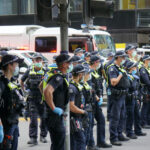Police Officer Charged Over Brutal Assault

A police officer who approached a member of the public from behind and violently threw him to the ground, leaving him in a pool of blood and urine, has been charged with recklessly causing injury and unlawful assault.
The man is seen standing alone and speaking with police officers at Melbourne’s Flinders Street Station, after a protest against COVID-19 lockdowns in September 2021.
He is standing still, is not acting aggressively and does not appear to pose a threat to anyone.
Despite this, the officer walks up to him from behind, grabs him by the shoulders and slams him to the hard floor.
Witnesses report hearing a loud crack as the man hit the floor, observing that the man was immediately knocked unconscious, and left in a pool of his own blood and urine.
Commissioner of Police ‘couldn’t be prouder’ of the conduct
At the time, Commissioner of Victoria Police, Shane Patton defended the actions of the police officer, making the astonishing assertion that he was “responding proportionately in an environment that was dynamic, threatening and frightening.”
“I couldn’t be prouder of them. What they’ve done and the way they’ve conducted themselves,” he remarked.
“Of course there’ll be incidents that appear, or may be inappropriate, but any of them that are, we will fully investigate”.
Commissioner Patron explained that the Police arsenal against protestors included foam batons, smoke bombs and stinger grenades which deploy rubber pellets.
In the days that followed, social media was filled with photos and videos of serious wounds suffered by people hit with rubber pellets, as well as police aggressively arresting anyone who looked like they were participating in the protests.
Officer acted unlawfully
After an internal police investigation, the case was referred to the Independent Broad-based Anti-corruption Commission (IBAC).
The Commission concluded that the officer did indeed acted unlawfully – a decision which surprised no one, except perhaps members of Victoria Police.
He has been charged with a number of offences, including recklessly causing injury and unlawful assault.
He was suspended on full pay in September 2021 and will face court later this year.
Assault offences in New South Wales
There is no offence of ‘recklessly causing injury’ or ‘unlawful assault’ in New South Wales.
There are, however, a broad range of similar assault offence whose maximum penalties depend on a number of factors, including:
- the defendant’s mental state (for example, whether the act was reckless or intentional),
- the extent of the injuries inflicted (for example, if the injury was merely ‘transient or trifling’ in which case the charge of common assault may be appropriate, or whether actual bodily harm was caused in which case the charge of assault occasioning actual bodily harm may be appropriate, or whether the very serious harm was caused in which case a grievous bodily harm charge may be appropriate),
- whether the offence was committed by the defendant alone or in the company of others, and
- the court in which the case is finalised (the maximum penalty for a single offence in the local court is 2 years in prison, whereas a higher statutory maximum penalty will apply in a higher court such as the district or supreme court).
Assault offences in New South Wales include:
Common assault
Common Assault is an offence under section 61 of the Crimes Act 1900 which carries a maximum penalty of 2 years in prison.
To establish the offence, police must prove beyond reasonable doubt that:
- You caused another person to fear immediate and unlawful violence, or that you made physical contact with another person, and
- The other person did not consent, and
- Your actions were intentional or reckless.
For a common assault to be established, there does not need to be an intention or power to use violence; it is enough for the other person to believe on reasonable grounds that there is an imminent danger of it.
Any injury caused must be no more than ‘transient or trifling’.
Assault occasioning actual bodily harm
Assault Occasioning Actual Bodily Harm is an offence under Section 59 of the Crimes Act 1900 which carries a maximum penalty of 5 years in prison or 7 years where committed with another person.
To prove the offence, the prosecution must prove beyond reasonable doubt that:
- You committed an act of violence towards another person,
- The act caused physical injuries that were more than ‘transient or trifling’, or the act caused very serious mental harm, and
- The other person did not consent to the act, and
- Your actions were intentional or reckless.
Examples of actual bodily harm include:
- a deep scratch or lasting bruises,
- a ‘black eye’, and
- a psychiatric condition.
Reckless wounding
Reckless Wounding is an offence under Section 35 of the Crimes Act 1900 which carries a maximum penalty of 7 years in prison.
To establish the offence, the prosecution must prove beyond reasonable doubt that:
- You wounded another person, and
- You did so recklessly
‘Wounding’ is the breaking of both layers of the skin being the dermis and epidermis and includes a ‘split lip’.
You were ‘reckless’ if you foresaw the possibility of wounding the other person which means you realised the wounding may occur, but went ahead with your actions regardless.
The maximum penalty increases to 10 years in prison where you committed the offence with another person or persons.
Recklessly causing grievous bodily harm in New South Wales
Recklessly Causing Grievous Bodily Harm is an offence under Section 35 of the Crimes Act 1900 which carries a maximum penalty of 10 years in prison.
To establish the offence, the prosecution must prove beyond reasonable doubt that:
- You caused grievous bodily harm to another person, and
- You did so recklessly
‘Grievous bodily harm’ (GBH) is defined as ‘very serious harm’ it includes, but is not limited to:
- Any permanent or serious disfigurement
- The destruction of a foetus, other than by a medical procedure, and
- Any grievous bodily disease
You were ‘reckless’ if you foresaw the possibility of inflicting GBH, which means you realised grievous bodily harm could result from your actions, but you went ahead with regardless.
The maximum penalty increases to 14 years in prison where you committed the offence with another person or persons.
Wounding or causing grievous bodily harm with intent
Wounding or Causing Grievous Bodily Harm with Intent is an offence under Section 33 of the Crimes Act 1900 which carries a maximum penalty of 25 years in prison.
To establish the offence, the prosecution must prove beyond reasonable doubt that:
- You caused grievous bodily harm to another person, or you wounded another person, and
- You intended to do so.
‘Grievous bodily harm’ (GBH) is defined as ‘very serious harm’. It includes, but is not limited to:
- Any permanent or serious disfigurement,
- The destruction of a foetus, other than by a medical procedure, and
- Any grievous bodily disease.
‘Wounding’ is the breaking of both layers of the skin being the dermis and epidermis and includes a ‘split lip’.
Legal defences to assault charges
If evidence of a legal defence is raised against an assault charge, the prosecution is then required to disprove that defence beyond a reasonable doubt.
If the prosecution is unable to do so, you are entitled to a verdict of not guilty.
Defences to assault charges include:
- Self-defence
- Duress, and
- Necessity
Going to court for an assault charge?
If you are facing assault allegations, call Sydney Criminal Lawyers anytime on (02) 9261 8881 to book a free first appointment with a defence lawyer who is vastly experienced in defending and winning assault cases.








